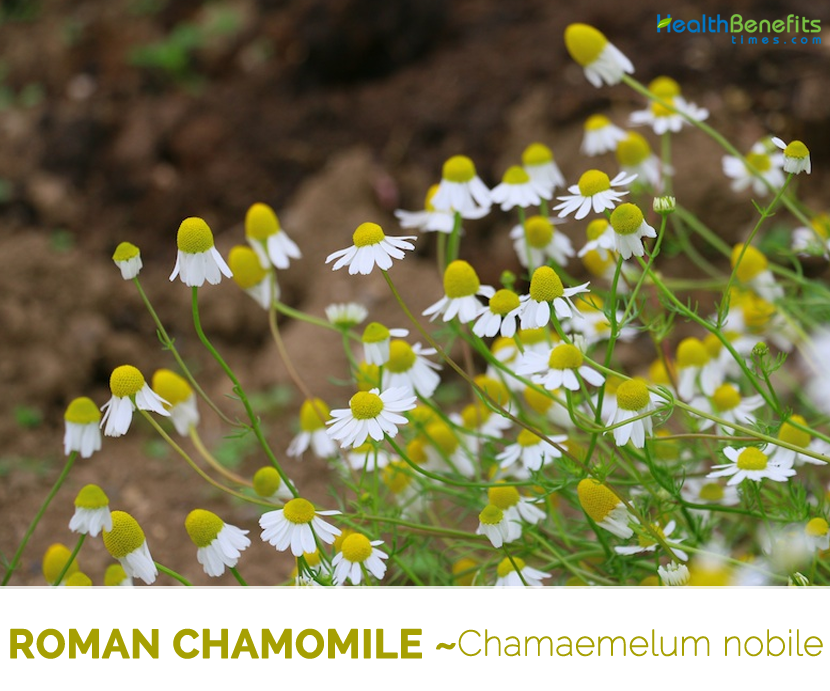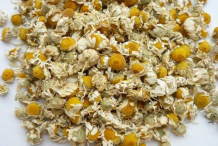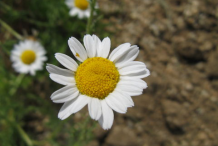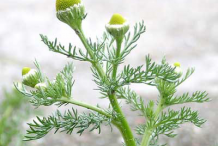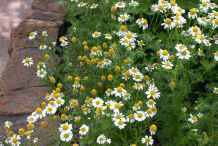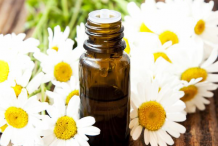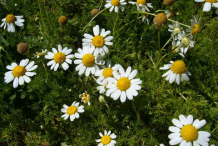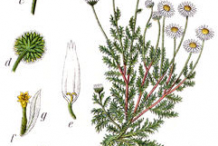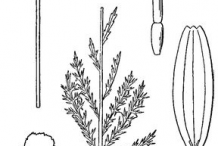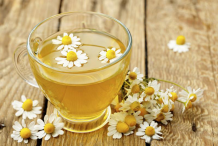Plant Description
Roman Chamomile is a low growing carpeting hardy perennial plant that grows about 10 – 30 cm (12 inches) tall. It is found growing in dry fields and around gardens and cultivated grounds and prefers average, medium, well-drained soil. The plant has hairy stem and leaves are alternate, bi-pinnate, finely dissected, and downy to glabrous. The plant has solitary, terminal flower heads, rising 20–30 cm (8–12 in) above the ground; consist of prominent yellow disk flowers and silver-white ray daisy-like flowers. Flowering normally takes place from May to September. Fruit is cypselas obovoid, 1 – 1.5 mm long, smooth, with 3 faint striae on inner side, bald.
Flower heads may be dried to make chamomile tea, a soothing herbal tea that has been a significant folk medicine remedy for a variety of ailments including headache, colds, flu, stomach disorders and gastrointestinal disorders.
History
Recorded use of roman chamomile dates back to the time of the ancient Egyptians. It was used for fevers, skin care, etc. The word ‘chamomile’ comes from the Ancient Greek word ‘Chamomaela‘and means ‘ground apple’. It was probably named after its scent, as the plant has an apple like smell to it.
Traditional uses and benefit of Roman Chamomile
- It is mainly useful as a remedy for various problems of the digestive system, as a sedative and a nervine; it is especially suited for young children.
- Tea is made from the flowers and this should be prepared in a closed vessel to prevent loss of the essential oils.
- Flowers are anodyne, anti-inflammatory, antispasmodic, nervine, stomachic, tonic, and vasodilator.
- Whole herb is used to make a lotion for external application in the treatment of toothache, earache, neuralgia etc.
- It is used for various digestive disorders including indigestion, nausea, vomiting, loss of appetite, and intestinal gas (flatulence) due to mental stress.
- Women use it for morning sickness and painful menstrual periods.
- It is also used for pain and swelling of the lining of the nose and mouth, sinus pain (sinusitis), and joint (rheumatic) disorders.
- It is applied directly to the skin for pain and swelling (inflammation) and as a germ-killer in ointments, creams, and gels used to treat cracked nipples, sore gums, and irritation of the skin.
- It is also used topically for wounds, burns, eczema, frostbite, diaper rash, bedsores (decubitus ulcers), and hemorrhoids.
- It is occasionally mixed with other herbs and taken by mouth for liver and gallbladder disease, gallstones, fatty liver, chronic heartburn, loss of appetite, digestive disturbances, a heart condition called Roemheld’s syndrome, indigestion in infants, and certain types of constipation.
- It is used as a “blood purifier” and general female tonic; and to prevent menstrual cramps and irregular periods.
- Some people put Roman chamomile in a steam bath and inhale it for sinus inflammation, hay fever, sore throat, and ear inflammation, and as a painkiller.
- Tea made from the flowers is used to treat digestive problems such as nausea, morning sickness colic and stress related dyspepsia.
- It is also good for feverish illnesses and insomnia.
- Teas have been used as a hair tint and conditioner, and to treat parasitic worm infections.
- It is used for pain and swelling of the lining of the nose and mouth, sinus pain, and joint disorders.
https://www.youtube.com/watch?v=2UoBypqC0c4
Ayurvedic Health benefits of Roman Chamomile
- Relief for migraines, headaches and nervous complaints: Simply mix with carrier oil and put in a burner or diffuser.
- Alleviating allergies, colic, insomnia, addiction and muscle pain: Blended in massage oil or diluted in your bathwater.
- Soothing diaper rash, burns and sunburn when added to creams and lotions.
- Treat dental abscesses and tonsillitis: Mixed in water and gargled as a mouthwash.
- Allergies: Diffuse a diluted mix through your home before the start of allergy season. You can also apply it on the bottom of your feet or inhale it directly when allergies flare up.
- Skin Irritation: It can help calm or treat acne, rashes, eczema, wounds, dermatitis and dry and itchy skin.
- Infections caused by bacteria and fungi: When digested, it can help kill all sorts of intestinal worms. You can also apply it to your hair to kill mites and lice, keeping your hair and scalp free from infections.
- Muscle Spasms, crams and tension: Just massage onto the affected area with a mild carrier oil, like coconut oil.
- Arthritis and rheumatism: It can relieve circulatory system disorders by stimulating your circulation and helping remove toxins like uric acid from the blood.
- Insomnia: Inhale or diffuse it before bedtime to help you get a good night’s sleep.
Culinary Uses
- Young sprigs are used as a seasoning and a flavoring in herb beers.
- Fresh or dried flowers are used to make herb teas.
- Whole herb is used for making herbal beers.
- In foods and beverages, the essential oil and extract are used as flavor components.
How to Take It
Pediatric
Scientists have not researched Roman chamomile in children. Talk to your doctor to find the right dose before giving Roman chamomile to a child.
Adult
- Tea: Pour 1 cup of boiling water over 2 to 3 heaping tsp. (2 to 4 g) of dried herb, steep 10 to 15 minutes. Drink 3 to 4 times per day between meals.
- Bath: Use 1/4 lb. of dried flowers per bath, or add 5 to 10 drops of essential oil to a full tub of water to soothe hemorrhoids, cuts, eczema, perineal pain, or insect bites.
- Cream/Ointment: Apply cream or ointment containing 3 to 10% chamomile content.
Other Uses
- They should not be stored for longer than 12 months.
- Essential oil is used in aromatherapy.
- An infusion of the flowers is used as a hair shampoo, especially for fair hair.
- It is also used as a liquid feed and general plant tonic effective against a number of plant diseases.
- It has fungicidal properties and its use is said to prevent damping off in seedlings.
- Whole plant was formerly used as a strewing herb.
- Whole plant is insect repellent both when growing and when dried.
- An essential oil from the whole plant is used as a flavoring and in perfumery.
- Yellow to gold dyes are obtained from the flowers.
- Plant makes a very good ground cover and can also be used as an edging plant.
- Flower heads are used to make medicine.
- It is used as a fragrance in soaps, cosmetics, and perfumes; and to flavor cigarette tobacco.
- Extract is also used in cosmetics and soaps.
- Teas have been used as a hair tint and conditioner, and to treat parasitic worm infections.
- Fragrant, apple-like scented flowers are used to produce the essential oil.
- It is used to make a rinse for blonde hair.
Precautions
- Patients with severe allergic responses to ragweed (ragwort) should be warned about the possible cross-sensitivity to chamomile and other members of the Asteraceae/Compositae family.
- Avoid during pregnancy and breast feeding.
- Chamomile may make asthma worse, so people with asthma should not take it.
- Drinking a lot of highly concentrated chamomile tea may cause vomiting.
- Chamomile may cause drowsiness, so do not take it and drive.
- Stop taking chamomile at least 2 weeks before surgery or dental work, because of the risk of bleeding.
- The herb, when taken internally in excessive doses, can induce vomiting and produce vertigo (dizziness).
References:
https://www.itis.gov/servlet/SingleRpt/SingleRpt?search_topic=TSN&search_value=501396#null
http://davesgarden.com/guides/pf/go/32272/
http://www.pfaf.org/user/Plant.aspx?LatinName=Chamaemelum+nobile
http://www.missouribotanicalgarden.org/PlantFinder/PlantFinderDetails.aspx?kempercode=b144
http://www.floracatalana.net/chamaemelum-nobile-l-all-
https://medlineplus.gov/druginfo/natural/752.html
https://plants.usda.gov/core/profile?symbol=chno3
http://www.umm.edu/health/medical/altmed/herb/roman-chamomile
http://www.encyclopedia.com/plants-and-animals/plants/plants/chamomile
https://en.wikipedia.org/wiki/Chamaemelum_nobile
Comments
comments
| Roman Chamomile Quick Facts | |
|---|---|
| Name: | Roman Chamomile |
| Scientific Name: | Chamaemelum nobile |
| Origin | Western Europe (Spain, Portugal, France, the United Kingdom and Ireland) |
| Shapes | Cypselas obovoid, 1 – 1.5 mm long, smooth, with 3 faint striae on inner side |
| Taste | Bitter |
